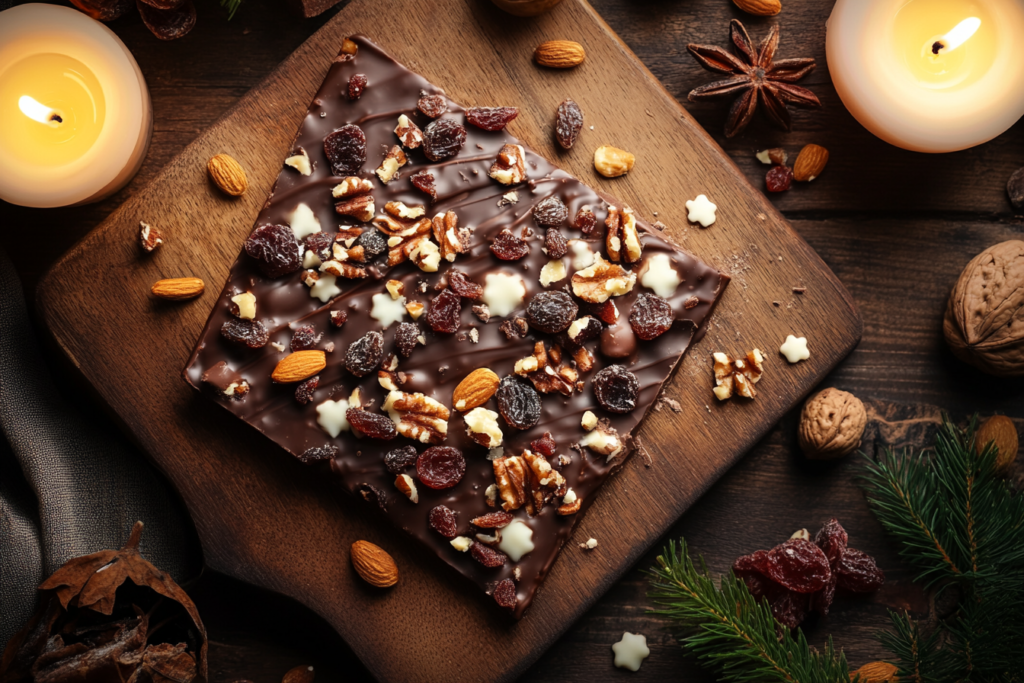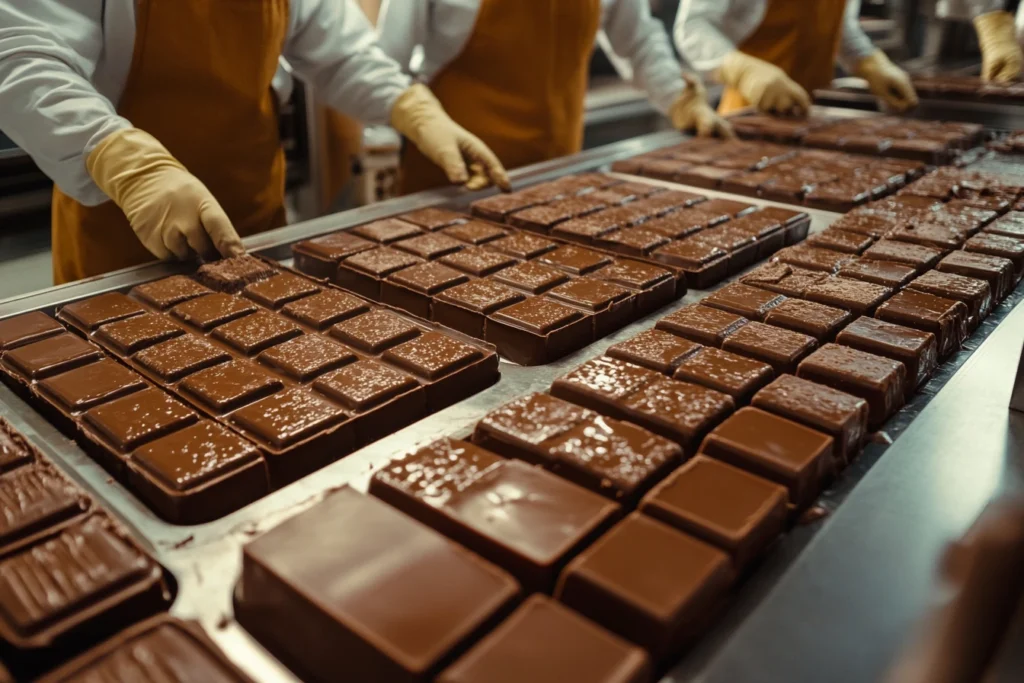1. Introduction to Chocolate Bars
Chocolate bars have become one of the most popular treats globally, loved for their sweetness, creamy texture, and rich flavor. These versatile snacks are not only enjoyed as quick indulgences but also serve as essential ingredients in desserts, baking, and even savory recipes.
With a history rooted in ancient civilizations, it have transformed from ceremonial beverages to modern confections available in various flavors, fillings, and textures. Whether crafted with dark, milk, or white chocolate, they cater to a wide range of preferences.
This guide provides an in-depth exploration of it, including their origins, types, nutritional benefits, and culinary uses. It also covers storage tips and addresses frequently asked questions to help readers make informed choices about these delicious treats.
2. History and Evolution of Chocolate Bars
Chocolate bars have a rich history that spans thousands of years, beginning with ancient civilizations and evolving into the modern-day treats we enjoy today.
2.1 Origins of Chocolate in Ancient Civilizations
The story of chocolate begins with the ancient Mayan and Aztec civilizations in Mesoamerica. These cultures revered cacao beans, using them as currency and in ceremonial drinks. The Aztecs prepared a bitter cacao beverage called xocoatl, believed to have energizing and medicinal properties.
When Spanish explorers arrived in the Americas during the 16th century, they brought cacao beans back to Europe. Sugar and milk were eventually added to the mixture, transforming the bitter drink into a sweeter treat enjoyed by European aristocrats.
2.2 Development of Modern Chocolate Bars
Chocolate’s evolution into solid bars began in the early 19th century with advancements in processing techniques. In 1828, Coenraad van Houten developed the cocoa press, which removed cocoa butter from cacao beans, creating a finer, powdered form of chocolate.
This innovation laid the foundation for solid chocolate production. Later, in 1875, Swiss chocolatier Daniel Peter combined cocoa with condensed milk, inventing milk chocolate. His collaboration with Henri Nestlé revolutionized chocolate production, leading to the creation of smooth and creamy ones.
By the late 19th and early 20th centuries, companies like Cadbury, Hershey’s, and Mars began mass-producing it, making them widely accessible to consumers.
2.3 Chocolate Bars Today
Today, chocolate bars are enjoyed worldwide and come in a variety of forms, from classic milk chocolate to gourmet options infused with exotic ingredients. While mass production remains popular, there is also growing demand for artisanal and ethically sourced chocolate.
Modern innovations include organic, sugar-free, and vegan versions, catering to diverse dietary preferences. Additionally, the rise of premium brands has highlighted the importance of sustainable practices, ensuring fair trade and eco-friendly production.
The journey of chocolate bars, from ancient rituals to contemporary treats, reflects their enduring appeal across cultures.
3. Types of Chocolate Bars

Chocolate bars come in a wide range of varieties, each offering unique flavors, textures, and uses. From classic milk chocolate to exotic gourmet options, there’s a type of chocolate bar to suit every taste preference.
3.1 Milk Chocolate Bars
Milk chocolate bars are among the most popular and widely consumed varieties.
- Made with cocoa solids, cocoa butter, and milk, they offer a smooth, creamy texture.
- Typically sweeter than other types of chocolate, making them ideal for desserts and casual snacking.
- Commonly used in candy bars, truffles, and baking recipes.
Milk ones are loved by both children and adults, making them a staple in confectionery products.
3.2 Dark Chocolate Bars
Dark chocolate bars are known for their rich, intense flavor and high cocoa content.
- Made with little to no milk, focusing on cocoa solids and cocoa butter.
- Popular for their antioxidant properties and potential health benefits.
- Often labeled by cocoa percentage, ranging from 50% to 90%.
Dark chocolate pairs well with red wine, nuts, and fruits, making it a favorite for gourmet recipes and desserts.
3.3 White Chocolate Bars
White chocolate bars stand out for their buttery and sweet flavor.
- Made from cocoa butter, sugar, and milk solids, without cocoa solids.
- Creamy and smooth texture, often used in baking, coatings, and confections.
- Complements fruits like strawberries and raspberries in desserts.
Although not technically considered chocolate due to the absence of cocoa solids, white chocolate remains a popular choice for those who prefer a milder taste.
3.4 Ruby Chocolate Bars
Ruby chocolate is a newer addition to the chocolate family, made from ruby cocoa beans.
- Naturally pink in color, with no added dyes or flavors.
- Offers a fruity, tangy taste that differs from traditional chocolate varieties.
- Frequently used in gourmet products and upscale desserts.
Its unique flavor and aesthetic appeal make ruby chocolate a popular choice for celebrations and gifts.
3.5 Flavored and Filled Chocolate Bars
Flavored and filled chocolate bars add variety by incorporating different ingredients and textures.
- Include nuts, caramel, nougat, and fruit fillings for added flavor.
- Spiced ones may feature chili, cinnamon, or mint for a bold twist.
- Popular among consumers looking for exciting combinations.
These versions are perfect for snacking or adding texture to desserts.
3.6 Artisanal and Gourmet Chocolate Bars
Artisanal chocolate bars focus on quality and craftsmanship, often using organic and ethically sourced ingredients.
- Handcrafted in small batches, emphasizing flavor and texture.
- Feature exotic flavors such as sea salt, lavender, and matcha.
- Prioritize sustainability and fair trade practices.
Gourmet variasions appeal to those who value premium ingredients and unique flavor profiles.
4. The Chocolate Bar Production Process

The production of chocolate bars involves multiple stages, combining traditional craftsmanship with modern techniques. Each step plays a critical role in creating the smooth texture and rich flavors that chocolate lovers enjoy.
4.1 Harvesting and Fermenting Cacao Beans
The process begins with harvesting cacao pods from cacao trees, which thrive in tropical climates.
- Farmers carefully cut the pods from trees and split them open to extract the cacao beans.
- The beans are fermented for several days in wooden boxes or banana leaves. This process enhances their flavor by reducing bitterness and developing complex aromas.
- Fermented beans are then dried under the sun to remove moisture and prevent spoilage.
Proper fermentation is essential for developing the distinctive flavors associated with high-quality ones.
4.2 Roasting and Grinding Beans
Once dried, the beans are roasted to deepen their flavor and remove any remaining moisture.
- Roasting times and temperatures vary, depending on the type of chocolate being produced.
- After roasting, the shells are removed, leaving behind cacao nibs, which are crushed into a paste known as chocolate liquor.
This stage forms the foundation for creating smooth and flavorful versions.
4.3 Conching and Tempering Chocolate
Conching is a refining process that gives chocolate its silky texture and balanced flavor.
- The chocolate liquor is mixed with sugar, cocoa butter, and milk powder (for milk chocolate) in large machines called conches.
- Continuous stirring during conching smooths the mixture and reduces bitterness.
Tempering follows to stabilize the chocolate’s structure and create a glossy finish.
- The chocolate is heated, cooled, and reheated to specific temperatures.
- This process ensures that the chocolate sets properly and produces a satisfying snap when broken.
4.4 Molding and Packaging
The tempered chocolate is poured into molds to form bars.
- Molds may be plain or include patterns and logos for branding.
- After cooling and solidifying, the bars are carefully removed and wrapped in foil or paper.
Modern packaging techniques not only preserve freshness but also highlight branding and sustainability. Many companies now use eco-friendly materials to meet environmental standards. To learn more about sustainable cocoa farming and packaging practices, visit the World Cocoa Foundation for detailed insights.
5. Nutritional Value and Health Benefits of Chocolate Bars
Chocolate bars are not only delicious but also contain nutrients that offer potential health benefits when consumed in moderation. Their nutritional profile varies depending on the type of chocolate, with dark chocolate being the most nutrient-dense option.
5.1 Macronutrients and Calories
Chocolate bars are energy-dense due to their combination of carbohydrates, fats, and proteins.
- Carbohydrates provide quick energy, especially in milk and white versions, which contain added sugars.
- Fats, primarily from cocoa butter, contribute to flavor and texture while supplying long-lasting energy.
- Protein content is modest but supports muscle repair and growth, particularly in nut-filled ones.
Caloric content depends on the type:
- Milk chocolate: About 150–170 calories per ounce.
- Dark chocolate: Around 160–180 calories per ounce.
- White chocolate: Typically 150–160 calories per ounce.
Because of their calorie density, portion control is recommended for those managing weight or calorie intake.
5.2 Vitamins and Minerals
Chocolate bars provide important vitamins and minerals, especially dark chocolate, which retains more nutrients from cacao beans.
- Magnesium supports muscle and nerve function, aiding in energy production.
- Iron contributes to red blood cell formation and prevents fatigue.
- Copper and manganese promote antioxidant activity and bone health.
- Calcium in milk and white ones strengthens bones and teeth.
Dark chocolate, in particular, offers a higher concentration of these nutrients due to its lower sugar content and higher cacao percentage.
5.3 Antioxidant Properties
Dark chocolate is rich in antioxidants, including flavonoids and polyphenols, which help combat oxidative stress.
- Flavonoids improve blood flow, reducing the risk of heart disease and lowering blood pressure.
- Polyphenols may help reduce inflammation and improve cholesterol levels.
- Researchers have linked antioxidants in dark chocolate to improved brain function and mood regulation.
Consuming chocolate with at least 70% cacao ensures the highest antioxidant content, offering more health benefits.
5.4 Sugar and Additives
While chocolate bars are nutrient-rich, many varieties contain added sugars and flavorings.
- High sugar intake can lead to weight gain, blood sugar spikes, and dental issues.
- Some of those include additives like emulsifiers, which may not be suitable for certain diets.
- Health-conscious consumers can opt for sugar-free or reduced-sugar versions made with natural sweeteners like stevia or erythritol.
Reading labels is essential to selecting needed ones that fit dietary needs and preferences.
5.5 Dietary Considerations
Chocolate bars can be adapted to suit various diets, including:
- Keto-friendly bars with low carbohydrates and high fat content.
- Vegan versions bars made with plant-based milk and sweeteners.
- Gluten-free options for those with gluten sensitivities.
These alternatives allow consumers to enjoy different versions without compromising dietary restrictions.
6. Frequently Asked Questions (FAQs) About Chocolate Bars
6.1 Are Chocolate Bars Healthy?
Chocolate bars can be healthy when consumed in moderation, especially dark chocolate with high cacao content. Dark chocolate is rich in antioxidants, iron, and magnesium, which support heart health and blood circulation. However, milk and white chocolate varieties may contain added sugars, so portion control is essential.
6.2 What Is the Difference Between Milk and Dark Chocolate Bars?
Milk chocolate bars combine milk solids, creating a creamier and sweeter taste. In contrast, dark chocolate contains higher cacao content and less sugar, resulting in a richer flavor and better nutritional profile due to its antioxidants.
6.3 Can Chocolate Bars Be Vegan?
Yes, many brands offer vegan chocolate bars made with plant-based milk like almond, oat, or coconut milk. Vegan options exclude dairy ingredients while retaining the richness of cocoa butter for texture.
6.4 Do Chocolate Bars Expire?
Chocolate bars have a long shelf life, often lasting up to two years if stored properly. However, exposure to humidity or heat can cause blooming, where sugar or fat crystals form on the surface. While bloomed chocolate is safe to eat, it may lose its texture and flavor.
6.5 What’s the Best Way to Melt Chocolate Bars?
For best results, melt chocolate bars using a double boiler or microwave in short intervals, stirring between each session to prevent burning. If you want to learn techniques to harden melted chocolate, follow this step-by-step guide to achieve the perfect texture for homemade bars and toppings.
7. Conclusion
Chocolate bars have remained a timeless indulgence with a rich history, offering both flavor and versatility. From milk and dark chocolate to ruby and gourmet varieties, they continue to cater to diverse preferences and dietary needs.
Beyond their taste, chocolate bars provide nutritional benefits, particularly in dark chocolate, which supports heart health and mood enhancement when enjoyed in moderation. Their use in desserts, snacks, and even savory recipes highlights their culinary flexibility.
By following proper storage tips and exploring healthier options, chocolate lovers can savor these treats while maintaining balanced diets. Whether you’re enjoying a simple milk chocolate bar or experimenting with artisanal flavors, they remain a global favorite for all occasions.
